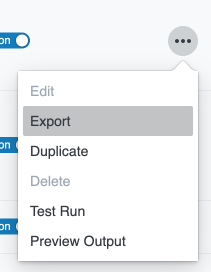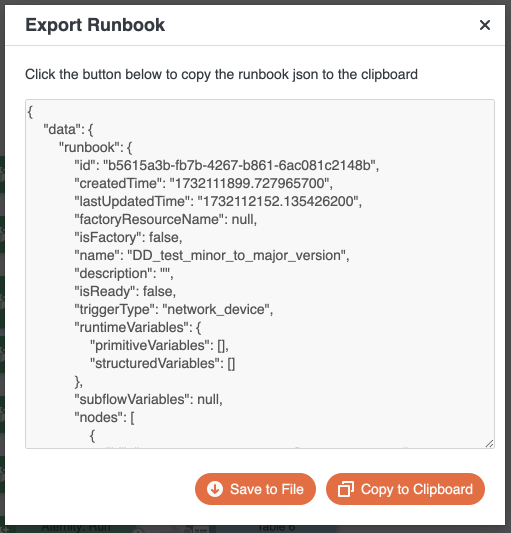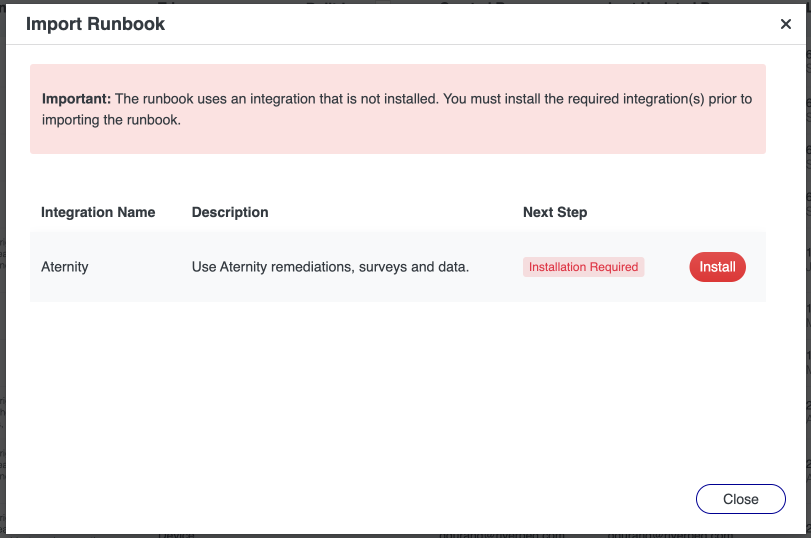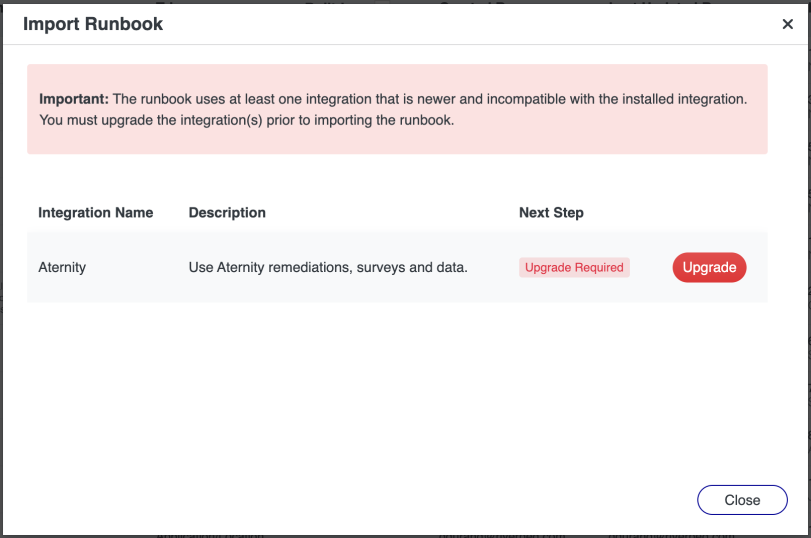Importing and Exporting Runbook Definitions
You can import and export runbook definitions with a JSON file.
Import a runbook definition
To import a runbook definition:
-
Click Import on the Runbooks page.
-
The Import dialog appears, prompting you to choose a JSON file to import.
-
-
Click Save to execute the import process. The new runbook is listed on the Runbooks page.
Export a runbook definition
A runbook can exported from two places:
-
The runbook editor, by clicking on the “Export” tool icon:

-
The Runbook List page, by clicking on the Export menu item:

After initiating the Export, the runbook definition is shown as JSON in the Export Runbook dialog. You can either:
-
Click Copy to Clipboard to collect the JSON code, paste the JSON code into an editor of your choice, and save it with a meaningful filename.
-
Click Save to File to save the runbook definition JSON file locally.

Importing a runbook containing integration subflow nodes
Importing runbooks containing subflows requires additional steps. These extra steps could include:
-
Installing an integration.
-
Upgrading an integration.
-
Confirming integration connectors.
-
Editing the imported runbook.
These extra steps can be required because the subflow referenced in the runbook could be a different version than the one installed on the system, or is not present on the system.
If an integration installation or upgrade is required, the import will not complete. You must import the file again after the integration prerequisites are satisfied.
The following five subsections detail various import scenarios.
Integration installation is required.
If the runbook contains subflows from integrations that are not installed, a dialog will list all integrations that must be installed before trying to import the runbook. An Install button links to the Integrations Library page where the required integrations can be installed. Once installed, you must close the dialog and try importing again.

Integration update is required.
If the runbook contains subflows from an integration and the installed version has a lower major version, you will need to upgrade the integration. For example, an upgrade is required if a runbook contains subflows from integration version 3.2.0 and the installed integration is version 1.4.0.
An Upgrade button links to the Integrations Library page where the integrations can be upgraded. Once upgraded, you must close the dialog and try importing again.

Integration upgrade is recommended.
If the runbook contains subflows from an integration, and the installed version has a lower minor version, the integration should be upgraded to get the latest enhancements and ensure consistent behavior. For example, an upgrade is recommended if a runbook contains subflows from integration version 3.2.0 and the installed integration is version 3.1.0.
An Upgrade button links to the Integrations Library page where the integrations can be upgraded.
Connectors need to be selected
Importing the runbook requires selecting connectors for various integration subflows used in the runbook. For integrations with Service Tags, the tags restrict the selection of connectors.

Importing a runbook containing user-defined subflow nodes
A runbook containing user-defined subflows will properly import into a system as long as it was exported from the same system and the original subflow wasn't modified after the runbook export took place.
A runbook containing user-defined subflows requires manual changes if imported onto a different system than the one used for export. Once imported, the runbook will show white nodes instead of subflow nodes. First, the original subflow must be imported onto the system. Then, the white node must be replaced by the subflow and reconnected in the runbook editor.